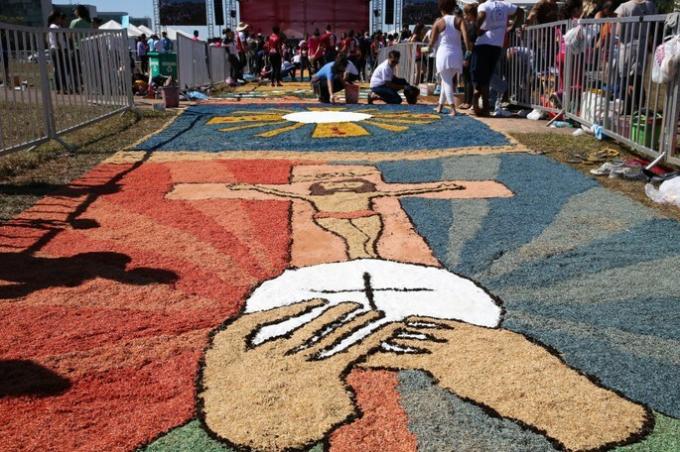Corpus Christi, which means “body of Christ”, is a Christian religious solemnity that celebrates the institution of the Eucharist, a Catholic sacrament in which the faithful receive a small particle from the priest, believing it to be the body of Jesus.
This date recalls the act performed by Jesus on Holy Thursday, the day before his death, when he had supper with His followers, and breaking bread and parting wine, Jesus said, “Take and eat, this is mine body. Take and drink, this is my blood.”.
This historic occasion is considered to be the one on which the sacrament of the Eucharist was instituted. Therefore, at masses, priests imitate the sharing of bread and wine at the altar, saying the same words spoken by Jesus.
At that moment, the wafers - flour particles - as well as the wine used in the mass, become respectively the body and blood of Jesus, the Eucharist, which in Theology is called transubstantiation.
Corpus Christi day
Corpus Christi Day, celebrated this year on the day June 11, 2020
, is a mobile commemorative date, but always celebrated on a Thursday, recalling Holy Thursday.It takes place 60 days after Easter Sunday, which is also the first Thursday after Holy Trinity Sunday.
According to the law, this day not considered a holiday, but an optional point., which means that it is up to each state or municipality to give the employees the rest day. In the case of holidays, rest is mandatory.
History and origin of the celebration
The origin of Corpus Christi is Belgian and dates back to the 13th century. The date was instituted by Pope Urban IV through the Bull “Transiturus de Hoc Mundo”, of 11 August 1264, having been promulgated in 1317 by Pope John XXII.
It all happened when, at age 16, St. Juliana of Cornillon would have received the first revelation of Jesus' desire to institute a liturgical feast for her body.
Years later, when she was superior of a convent, Juliana de Cornillon shared her vision with other religious. Gradually, the commemoration became a national festival in Belgium, until it came to be celebrated by the Catholic Church throughout the world and officially instituted by the Pope after the Miracle of Bolsena in 1264.
In 1264, a priest who was always distressed at not believing faithfully in transubstantiation witnessed a wafer spilling blood as he celebrated Mass. Impressed, the priest informed the pope about what had happened, who sent a bishop to collect the relic.
This spurred the celebration of Corpus Christi throughout the church and not just in Belgium, as it had been done before. However, Pope Urban IV died in October 1264, which delayed the official adoption of the date. It was not until 1311, at the general council in Vienna, that the matter was taken up by Pope Clement V and, in 1317, the celebration of Corpus Christi was finally promulgated throughout the world.
How is the date celebrated in Brazil?
In Brazil, Corpus Christi is celebrated with masses and processions, which are brightened with the extensive rugs made by the faithful who take pains to see Jesus pass.
In the procession, the priest steps on the carpet carrying the monstrance, where a consecrated host is placed - it is called the Blessed Sacrament - which is displayed to be an object of adoration.

Using flowers, sawdust, dyed sand and flour, coffee grounds and recycled materials, people prepare months in advance to make these rugs. His images mainly represent chalices, bread and wine, pigeons and the cross.
Our traditions of celebrating Corpus Christi have Portuguese origins, arising during colonization.
See too June commemorative dates


